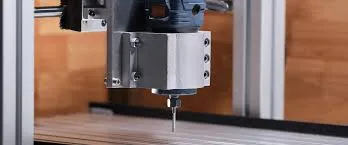Understanding what materials can and cannot be used in a CNC router is crucial to maximizing its potential and avoiding damage to both the machine and the material. Moreover, alternative cutting methods can be explored for challenging materials to achieve the desired results.
This article delves into the materials suitable for CNC router services, those that present difficulties, and the various cutting techniques that can serve as alternatives for tough-to-machine substances. By the end of this guide, manufacturers, engineers, and designers will gain a deeper understanding of CNC router service capabilities, helping them make informed decisions in material selection and processing.
What is a CNC Router?
A CNC router is a powerful machine used in various industries to cut, carve, and shape materials with high precision. It operates based on pre-programmed software, translating digital designs into physical outputs using rotating cutting tools. The versatility of CNC routers makes them popular in woodworking, plastic fabrication, and metalworking, where precision and repeatability are critical.
Unlike traditional manual routers, CNC routers automate the entire cutting process, allowing for faster production speeds and higher levels of complexity in designs. By following the computer-generated instructions, the router can create intricate patterns and shapes that would otherwise be difficult or time-consuming to achieve by hand.
The key to understanding CNC routers’ capabilities lies in recognizing the types of materials they can handle and where their limitations lie. This article examines the materials suitable for CNC routers, those that pose challenges, and alternative methods for working with tough materials.
What Materials Can Be Used in a CNC Router?
CNC routers are highly versatile and capable of cutting various materials. The selection of materials depends on the power, speed, and tooling of the CNC router. Here are the most common materials suitable for CNC routing:
Wood
Wood is one of the most common materials used in CNC routing, making CNC routers a staple in the woodworking industry. Wood’s relative softness and flexibility allow for easy cutting and shaping. CNC routers can handle different types of wood, including:
Softwoods (e.g., pine, cedar): These woods are lightweight and easy to cut, making them ideal for projects that require speed and less wear on the router’s tools.
Hardwoods (e.g., oak, maple): Although denser and harder to cut than softwoods, CNC routers can carve intricate designs into hardwoods, making them suitable for furniture and detailed decorative items.
Plywood and MDF: Engineered wood products like plywood and MDF (medium-density fiberboard) are commonly used in CNC routing due to their uniform texture and ease of use. They are ideal for cutting large panels or creating composite structures.
Plastics
CNC routers excel at cutting various types of plastics, which are used in industries such as automotive, aerospace, and consumer products manufacturing. Some of the common plastics compatible with CNC routers include:
Acrylic (PMMA): Known for its transparency and strength, acrylic is a popular plastic for CNC routing. It is used in display cases, signage, and lighting fixtures. CNC routers produce clean cuts and smooth edges with acrylic.
Polycarbonate: More durable than acrylic, polycarbonate is often used when strength and impact resistance are required. CNC routers can cut polycarbonate, but careful cutting speed and cooling control are needed to avoid melting.
Polyethylene and PVC: Both materials are highly workable with CNC routers and are used in various industrial applications. They are relatively soft and easy to cut, but they require proper tool selection to avoid issues like burrs or melting.
Aluminum (Soft Metals)
Although CNC routers are not typically designed for heavy metalworking, many machines can handle softer metals like aluminum. Aluminum is a popular material due to its lightweight properties and excellent machinability. With the right router settings, aluminum sheets can be cut, engraved, and shaped with precision. However, cutting metals with a CNC router requires slower speeds and specialized tools to prevent tool wear and ensure a clean finish.
Foam and Composite Materials
Foam materials, such as expanded polystyrene (EPS) or polyurethane, are commonly used for creating molds, prototypes, and packaging. CNC routers are effective for cutting foam due to their softness and lightweight properties. Additionally, composite materials like fibreglass-reinforced plastics (FRP) or carbon fiber can be cut with CNC routers. These composites are used in high-performance applications like aerospace, automotive, and sports equipment manufacturing.
Laminates
Laminates are layered materials made of paper, fabric, or wood bonded together with resin and are suitable for CNC routing. They are commonly used for countertops, cabinetry, and decorative surfaces. CNC routers can cut through laminates cleanly without chipping the edges, making them ideal for detailed kitchen and furniture manufacturing.
What Materials Can Not Be Used in a CNC Router?
While CNC routers are versatile, they have limitations, especially for certain materials. Using incompatible materials can damage the machine or result in poor-quality cuts. Here are materials that cannot or should not be used with CNC routers:
Hardened Metals
CNC routers are generally unsuitable for cutting hard metals such as steel, stainless steel, and titanium. These materials require much more powerful machinery, like CNC mills or laser cutters to cut effectively.
The high hardness of these metals can cause rapid wear on the router’s tools, and the machine may not generate enough force to cut through the material cleanly. The heat generated during cutting could also damage the material or the router itself.
Glass
While CNC routers can handle acrylic and polycarbonate, they are not equipped to cut glass. Glass is brittle and prone to cracking or shattering under the high-speed rotational forces exerted by the router.
Special machinery, such as waterjet cutters or diamond-tipped saws, is required to cut glass effectively. These methods avoid the impact and vibrations that could compromise the material’s integrity.
Ceramics
Like glass, ceramics are extremely hard and brittle, making them unsuitable for CNC routing. The cutting tools used in CNC routers are not designed to withstand the extreme hardness of ceramics, which can cause the tools to break or dull quickly.
Additionally, the brittleness of ceramics means that the material is likely to crack under the pressure and speed of the router. CNC waterjet or laser cutters are more appropriate for cutting ceramic materials.
Concrete
Although CNC routers are designed to work with wood, plastic, and soft metals, concrete is beyond their capabilities. Concrete’s hardness and density require specialized tools such as diamond blades or core drills incompatible with standard CNC router bits. Concrete also generates dust that could damage the machine and create a hazardous environment for the operator.
Stone (Granite, Marble)
Stone materials such as granite and marble are also unsuitable for CNC routers. These incredibly hard and dense materials require special stone-cutting tools like diamond-tipped bits. Attempting to cut stone with a CNC router can result in severe damage to the machine and poor-quality cuts. In the stone industry, CNC waterjet or laser cutters are typically used to achieve precision cuts on these materials.
Alternatives Cutting Methods for Difficult Materials
Alternative cutting methods offer a more suitable solution for materials incompatible with CNC routers. Here are some options for cutting hard metals, glass, ceramics, and other difficult materials:
CNC Milling
CNC mills are the go-to machines for hard metals like steel, stainless steel, and titanium. They operate at lower speeds than routers but apply much more force, allowing them to cut through tougher materials. Mills use rotary cutters similar to routers but are built to handle the additional stress of cutting metal.
CNC Waterjet Cutting
Waterjet cutting is an ideal alternative for cutting glass, ceramics, and stone. A CNC waterjet cutter uses a high-pressure stream of water mixed with abrasive particles to cut through hard materials without generating heat, which reduces the risk of cracking or warping the material. Waterjet cutting is also used for metals like steel and aluminum, providing clean, precise cuts.
CNC Laser Cutting
CNC laser cutters use a concentrated beam of light to cut through materials, making them suitable for metals, ceramics, and even stone. Laser cutting offers high precision and is ideal for intricate designs or materials that require clean edges. Lasers also produce less waste and generate minimal heat, reducing the risk of material distortion.
Diamond-Tipped Saw Blades
Diamond-tipped saw blades are essential for cutting materials like stone or concrete. These blades are specifically designed to handle the hardness and density of such materials, making them a better option than traditional CNC router tools.
Conclusion
Choosing the right cutting method for your project depends on the material properties and the desired finish. Understanding the limitations of CNC routers will help you make informed decisions and ensure you use the appropriate machine and tools for each application. By leveraging the strengths of CNC routers and alternative cutting technologies, manufacturers can achieve high precision and efficiency in their fabrication processes.


